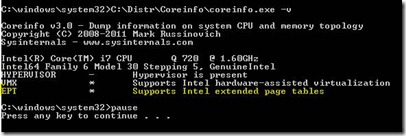Hyper-V on Windows 8 Client!
Be sure to read the great new posting on the “Building Windows 8” blog:
https://blogs.msdn.com/b/b8/archive/2011/09/07/bringing-hyper-v-to-windows-8.aspx
(Read through the comments too, which talk about support for sleep and hibernate.)
There is one prominent statement made:
Hyper-V requires a 64-bit system that has Second Level Address Translation (SLAT).
That means you have a great reason to consider using the 64-bit version of Windows 8, and why you should buy only hardware with 64-bit support. But what about the second part of that, SLAT support? Well, all you really need to understand is that SLAT is a processor feature that improves virtual machine performance, especially when using higher-end video cards (e.g. those used on client machines). Read more about the benefits in the Hyper-V R2 announcement:
https://technet.microsoft.com/en-us/library/dd446676(WS.10).aspx
This mentions that Intel and AMD have different implementations of this. Intel calls theirs “Enhanced Page Tables” (EPT), while AMD refers to it as “Nested Page Tables” (NPT). Regardless, what you really care about is whether or not a particular processor includes the support. That’s not always easy to figure out from the vendor’s web sites. Fortunately, there is a newly-updated tool available on the SysInternals web site called Coreinfo that will tell you all about a processor’s capabilities:
https://technet.microsoft.com/en-us/sysinternals/cc835722
Mark Russinovich updated this utility recently to add the ability to detect both Intel EPT and AMD NPT. Here’s what the output would look like if your machine has an Intel processor with the needed support:
The AMD output will be slightly different (and not because it’s on a white background instead of a black one):
In both cases, the asterisk (“*”) in the second column indicates that the feature is present. (A minus, “-“, shows if it isn’t.) Be careful if running this in a VM or on a machine currently running a hypervisor, as these will mask the real processor capabilities.)
So check out your machines today to see if they are ready for Windows 8 client Hyper-V!

